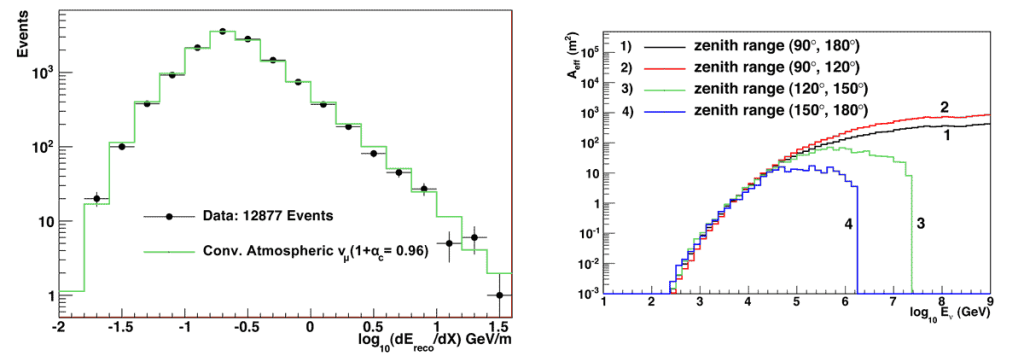Searching for a Diffuse Flux of Astrophysical Muon Neutrinos
One of the main strategies used to look for astrophysical neutrinos with IceCube is the search for a diffuse flux of high-energy neutrinos from unresolved sources. A hypothetical diffuse astrophysical muon neutrino flux would have a harder energy spectrum than atmospheric muon neutrino backgrounds. Therefore, evidence for a diffuse astrophysical muon neutrino flux would appear as a hardening of an energy-related observable distribution above the expected atmospheric neutrino background.
A search was performed using data from the IceCube detector collected in its half completed configuration in which 40 strings operated between April 2008 and May 2009. 12,877 candidate neutrino events were obtained from this data sample. Shown below is the muon energy loss distribution for the data together with the atmospheric neutrino model that explains the data best, which is 96 percent of the event rate predicted by the atmospheric neutrino model from Honda et al. (M Honda et al. Phys Rev D 75 043006 (2007) ). No evidence for a diffuse flux of muon neutrinos was found in this data set. Also shown is the effective area, which indicates the area of an equivalent detector 100 percent sensitive to through-going neutrinos. The effective area can be convoluted with a theoretical neutrino flux to give a predicted event rate.

Data release
The final 12,877 neutrino candidate events for the IC40 data set are tabulated in an ASCII format:
Click here to download (.zip, 340KB)
IceCube-40 String Data
Included in the data are the declination, right ascension, and the estimated energy deposition of the events in the IceCube detector. Also included are an estimate of the muon energy in the detector, the number of optical modules hit, and the event times in UTC and MJD.
Please cite this data as R. Abbasi et al, arXiv:1104.5187. Phys. Rev. D 84, 082001 (2011).
For any questions about this data release, please write to data@icecube.wisc.edu